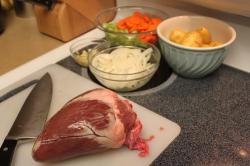Field to Fork: Preparing a mule deer heart

GAME FOR COOKING -- Most hunters relish bringing back their game for the family table. In the following story, a Montana hunter, mother, cook and comptetitive shooter tells about her adventure with saving a mule deer buck's heart from the gutpile and turning it into a feast.
Read on for the story and all the details via the Outdoor Wire.
By Julie Golob
Living in northeastern Montana, I don't exactly have many gourmet hot spots to frequent. Since moving here cooking has become a necessity, but it is also a hobby I enjoy. It also allows me to combine my love of hunting with experimenting in the kitchen.
I call my recipes my "Field To Fork" creations. My husband serves as my taste tester, providing his feedback in what I call his gourmet gauge. The gauge is based on how many m's in "Mmmmm" my dishes inspire. M is Good. Mm means yummy. Mmm translates to delicious. Mmmm inspires a, "shh... I need a moment to savor this." Finally, Mmmmm is the highest praise - dangerously delectable with high risk of food coma.
A good friend of mine gave me the idea of running a blog series on what dishes I prepared from the mule deer buck I took this hunting season. I loved the idea and for the series I plan to take my mule deer on a culinary world tour.
For my first dish, as you probably guessed from the title, I decided to cook venison heart. Often relinquished to the gut pile left in the field, deer heart isn't usually on the menu for many households. It's a dense meat with deep flavor. If it is not cleaned thoroughly it can have a mineral, metallic taste not unlike the very liquid it pumps.
Some people I know shudder at the mere thought of consuming heart, classifying it as offal and resort to name calling with another word that sounds almost the same. Thankfully my husband isn't one of them!
Gourmet magazine's archives revealed a recipe from 1944 for calf heart and lungs that was considered a delicacy. The text after the recipe says it all, "This exclusive recipe is pulled directly from Gourmet's archive. It has not been re-tested by our food editors since it was published in the magazine, but it's a pretty good indication of the kinds of things we once cooked-and ate-with great pleasure."
And I did feel pleasure in not wasting this portion of my mule deer and for the chance to make a delicious hearty dish - à cÅ“ur vaillant rien d'impossible!
Passion and decadence are two words that come to mind when I think of the word heart. At the surface, matters of the heart seem simple but dig deeper they are indeed quite complicated. What dish embodied all these things? Simple ingredients prepared in a complicated way with rich decadent flavors? The French classic Beef Bourgninon.
A little history on the dish thanks to Wikipedia, "Beef bourguignon is one of many examples of peasant dishes being slowly refined into haute cuisine. Most likely, the particular method of slowly simmering the beef in wine originated as a means of tenderizing cuts of meat that would have been too tough to cook any other way. Over time, the dish became a standard of French cuisine."
A quick recipe search on the internet, yielded some promising results like this one from Food Network's Barefoot Contessa, Ina Garten. I used this recipe as a guide, but made some variations of my own.
 |
Deer heart can be chewy so I wanted to remove any portion that had fat, arteries or that hard, outer coating. The first step was chopping it in half and then removing the top portion with the aorta and such.
 |
I cut the heart into one inch cubes and placed them in a bowl. I added two tablespoons of lemon juice to a cup of white wine, stirred it and then poured the liquid into the bowl, making sure the meat was covered. The wine and lemon juice served as a short marinade. Any remaining blood in the heart also settled out, so I think this is an important step.
 |
Why white wine instead of red in a "burgundy" dish? I chose to incorporate white wine because I didn't want the red wine flavor to be too bold. I knew the dish would be rich in flavor already with the heart meat.
 |
One teaspoon of salt, one half teaspoon of pepper, two bay leaves, one half teaspoon of dried thyme and ten small golden potatoes went in next. I stirred the mixture thoroughly reduced the temperature to low heat, covered and let cook for an hour and a half.
I didn't happen to have any fresh mushrooms on hand but I keep an assortment of dried mushroom in my pantry. I prepared them per package instructions by boiling two cups of water and pouring that into a bowl with a cup of the dried mushrooms. After letting them sit for five minutes I removed the mushrooms from the water, chopped them up into smaller pieces and added them to the dutch oven.
 |
Another 15 minutes on the burner, it was ready to serve with some fresh baked wheat bread. How did it rate on the Mmmmm scale? Mmm - DELICIOUS!
Julie Golob is a hunter, mother, housewife, author and the only shooter to have won a world title in every USPSA Competition.
